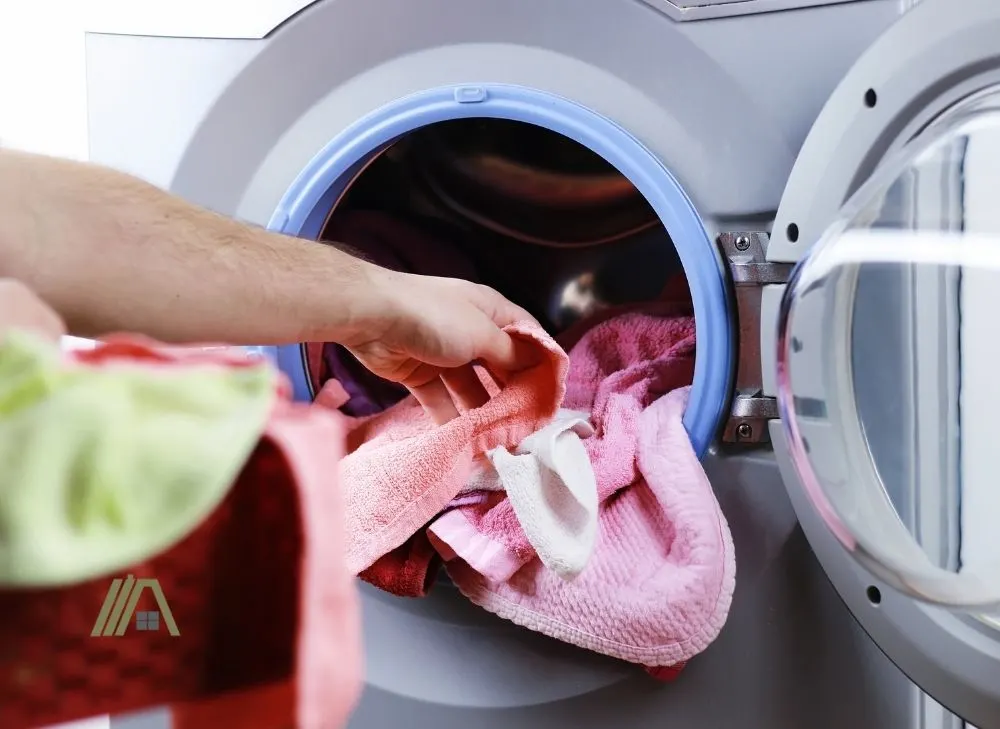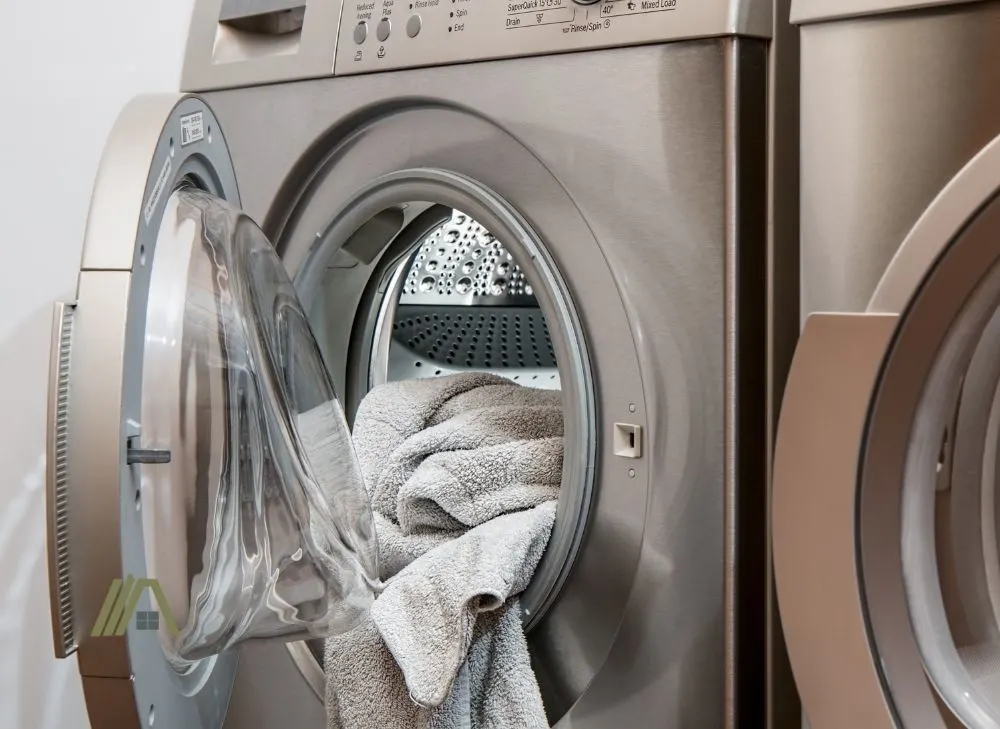| Pros of Having a Washer Dryer | Cons of Having a Washer Dryer |
| Having a combined washer and dryer machine is really great for smaller homes as you will only need space for one appliance instead of two. | Unfortunately, if you have a backlog of laundry, you cannot wash and dry at the same time. |
| Contrary to what you might think, having a single washer and dryer is only slightly more expensive than purchasing either a washer OR a dryer. | The wash function allows for a heavier load than the dryer function, so you will probably have to split the load in two once they have been washed. |
| With a washer dryer, you are not reducing the quality of your machines; you are just increasing the functionality as you have one single machine that does the job of two. | It will take longer for your clothes to dry in this combined unit than they would in a standalone dryer. |
| The energy used will be the same as if you had a separate washer and dryer. | |
| You don’t need to transfer clothes to a second machine after washing, which will save you precious time. | |
| Although the machines themselves are combined, the washer and dryer function separately. | |
| These machines are really not complicated at all, being extremely user-friendly. |

Washer dryer combos save space and cost. They are user-friendly and convenient. The drying and washing functions can be used separately. There’s no need to transfer a load to another unit. Drying takes longer and the drying capacity is small. It’s impossible to wash and dry clothes simultaneously.
Washer Dryer Pros
You Only Need Space for One Appliance
The combined washer-dryer machine is a truly great invention, especially for those with limited space in their homes.

Instead of having to find a place for two machines to be installed and function, you only need to have enough space for one appliance. This allows you to have more space in your laundry room, bathroom, or basement for other appliances and furniture.
It also makes having the machine in the master closet feasible even if the closet is smaller.
Price Comparable to Single Function Machine
Just because you are getting a two-in-one special does not mean that you will be paying an exorbitant price.
Your average higher-end washing machine will cost you around $2000 (lower-end ones are much cheaper and start at $250), and a dryer with high-quality functions will be less than $1000.
You might be surprised to find that the washer-dryer combo won’t cost you more than $1700. You can even get one for as little as $700, albeit one of lower quality with fewer adjustable settings.
Even if you decide to go for the lower-end models of washers and dryers, which might cost you around $500-$700 combined, a comparable washer-dryer unit will cost the same or only slightly more.
Performance Matches Stand-Alone Washers
You might be apprehensive about buying a combined washer-dryer machine. Surely one machine that has combined the jobs of two units cannot work as well as each individual unit could?
I am pleased to tell you that your fears are misguided. When you buy the singular unit, you aren’t giving up a high standard of performance at all. You are merely combining two well-functioning machines into one. The efficiency of the machine does not deteriorate just because it has extra functions.
You can rest assured that your clothes with be clean and dry after using such a machine. Just make sure not to overload the drum, particularly with very wet clothes to allow for maximum efficiency of each function.
Running Costs Aren’t Higher
Another great benefit of having a washer-dryer is that even though a singular unit runs double the number of functions, you won’t be paying double the cost.
If you had two separate machines, one for washing and one for drying, you would be paying for the water and electricity used for each machine.
In the case of the combined unit, you will still pay to run the washer functions, and then you will pay for running the dryer functions. The amount of energy used will be the same for one unit as it would have been for two separate ones. There is no extra energy usage because they are combined.
So, as long as you are prepared to pay for the costs involved in running two appliances, your budget won’t be affected when using one combined machine.
No Need to Transfer Clothes
One of the best benefits of a washer-dryer unit, in my opinion, is that you don’t need to transfer a load of clothes from the washer unit to the dryer unit.

Once the washing cycle has been completed, you can start the drying function by simply clicking a button or turning a dial (depending on your make and model).
The fact that you won’t need to take out the washed clothes and then put them into a separate machine will definitely save you time. Plus, this will be super helpful in winter, as handling wet washing in cold seasons can be extremely painful for your fingers.
Wash and Dry Functions Work Separately
Despite having one combined unit for two functions, it is great to know that each dryer and wash function work separately.
That means that you can select which function you want to activate once you put in a load of laundry. If you want to take advantage of a bright and sunny day and leave your clothes to air dry, then you don’t need to activate the dryer option. You can wash them and then hang them outside.
On the same note, if you have just quickly hand-washed your kid’s soccer uniform, then you can simply place it in the machine and select the dryer function. It isn’t necessary to use the washing function in order to use the drying function.
This is definitely convenient since it gives people the freedom to use the appliance as they wish.
Double Function Doesn’t Mean Less User-Friendly
If you don’t consider yourself very tech-savvy, then the fear of a complicated machine might put you off purchasing a washer dryer. However, you don’t need to worry that you’ll press the wrong button or cause your appliance to spontaneously combust.
Just because two separate machines have essentially joined to create one does not mean that there will be double the settings. Otherwise, it could result in confusion.
You’ll be glad to know that these appliances are really user-friendly. They should have clearly indicated buttons or dials that will show you exactly what to press based on your specific requirements.
Washer Dryer Cons
You Cannot Wash and Dry Simultaneously
One of the main disadvantages of such an appliance is that you cannot wash and dry two different loads of clothes simultaneously, as you would be able to do with two separate machines.

You will have to wait for the wash load to be complete before you can begin drying clothes: The same applies if you were drying a load and wanted to wash another bunch of clothes at the same time.
This can get frustrating if you have a big family with many laundry loads to do. The waiting game will definitely test your patience.
Even though the functions have been combined into one, the time necessary to free up the appliance has essentially doubled, which can be quite off-putting for some people.
Maximum Wash Load Too Much for Dryer
Another setback of the washer-dryer unit is that the amount of laundry allowed in the drum for the wash cycle is not the same as what is suitable for the dry cycle. The drying process needs more space to allow the clothes to get dried properly.
Since the wash load allows for a lot more clothes than the dryer does, you will likely have to split up the wet load after the washing cycle is finished. Thus, you will only do half a load at a time during the drying cycle, leaving one load in a bucket on the side.
This can be pretty annoying and time-consuming. So alternatively, you can wash smaller loads that can automatically go into the drying without needing to take out some clothes. However, this can take even more time as you will have to do more washing loads.
Drying Can Take Longer Than Stand-Alone Unit
Despite the fact that a washer-dryer unit can wash and dry your clothes as effectively as standalone units, the time it takes to do so is very different.
Washing your clothes in a single unit or a combined appliance will be done in essentially the same amount of time, obviously depending on the size of your load and the setting you choose.
However, your clothes can take a bit longer to dry in this combo appliance than if they were in a standalone dryer. Some people have said that an entire wash and dry cycle can take up to 3 hours—yikes!
The reason why the drying function takes so long is that the machine had washed clothes beforehand. Thus a lot more water needs to evaporate from the drum itself than it typically is when you’re transferring the clothes from one unit to another.
For some personal experiences with washer/dryer combo machines, check out Do Washer/Dryer Combo Machines Really Work?
Sources
https://www.goodhousekeeping.com/uk/product-reviews/electricals/g30729580/best-washer-dryers/
